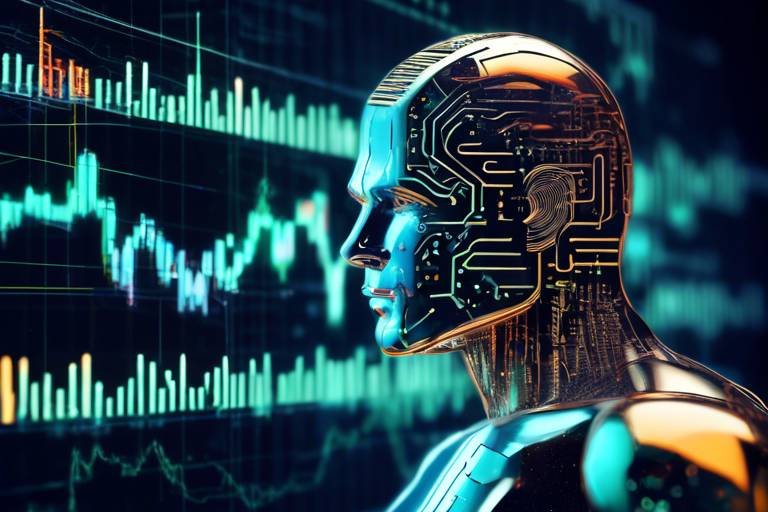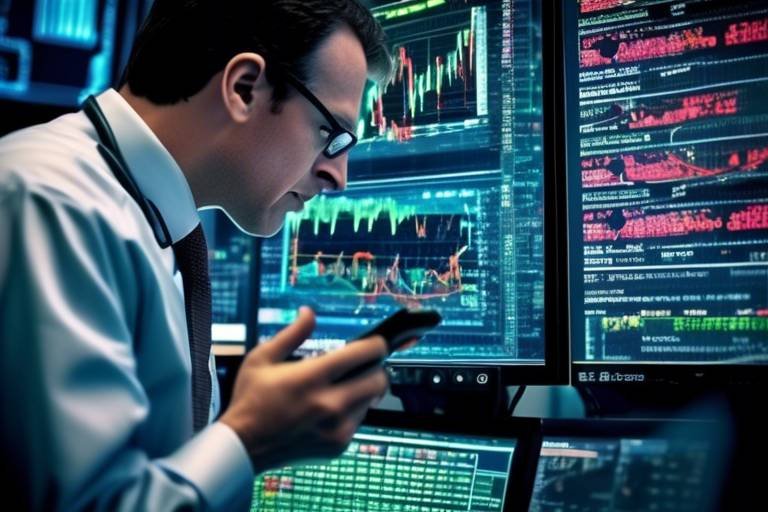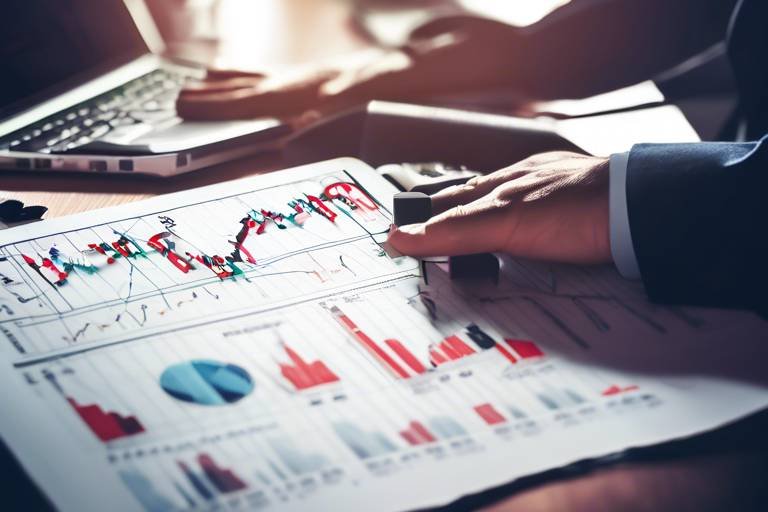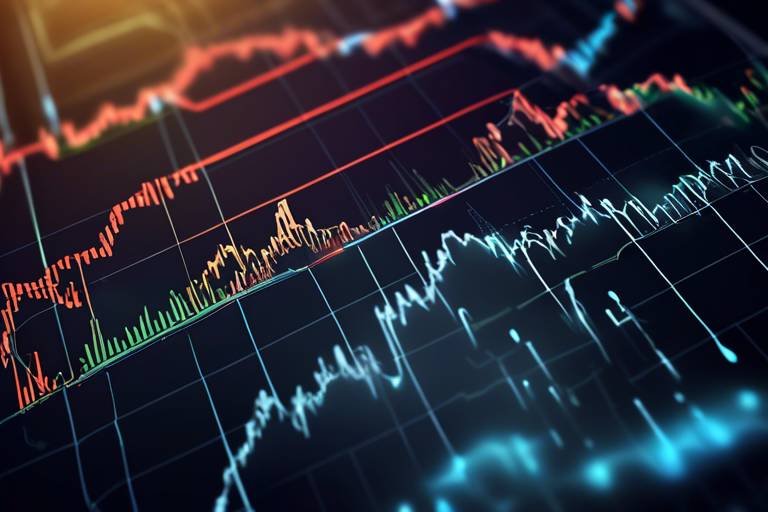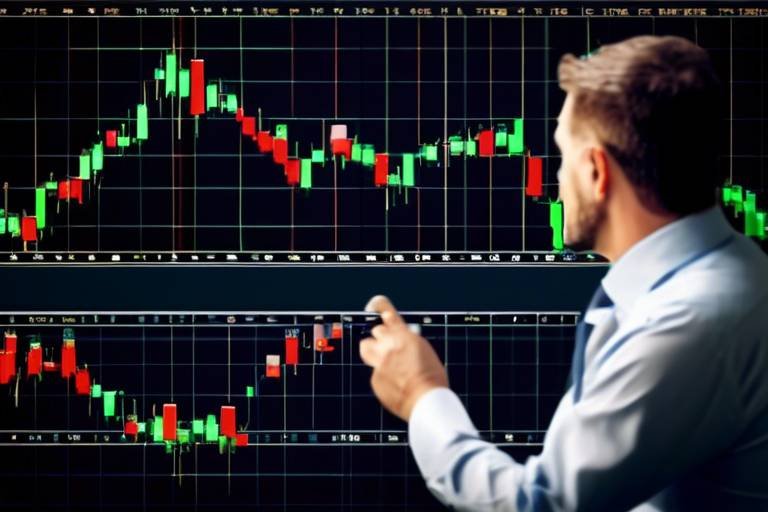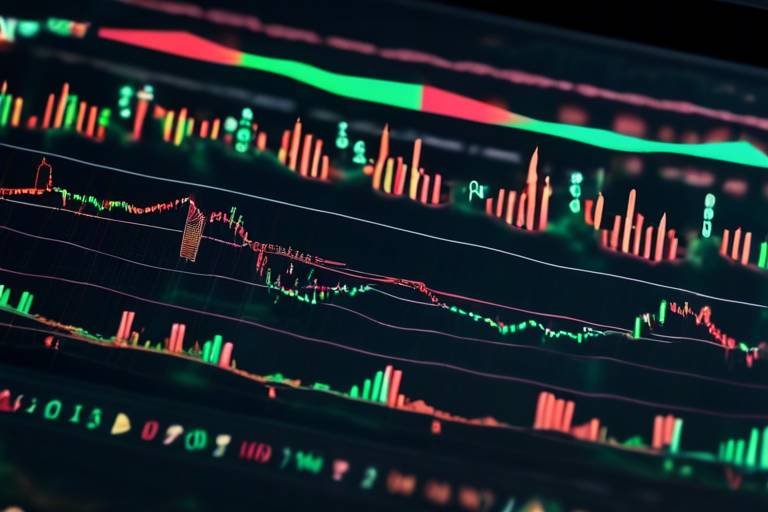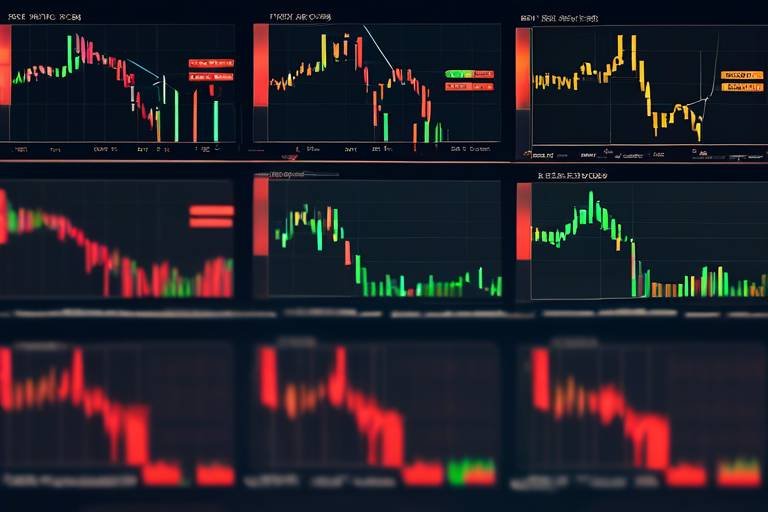Exploring the Use of AI in Crypto Technical Analysis
In the fast-paced world of cryptocurrency trading, the stakes are high, and the margins for error are razor-thin. As traders and investors navigate this volatile landscape, many are turning to artificial intelligence (AI) to enhance their technical analysis capabilities. But how exactly does AI improve the way we analyze crypto markets? This article delves into the transformative role of AI in technical analysis, revealing how it enhances predictive accuracy and decision-making for traders and investors alike.
To understand the impact of AI, we must first recognize the sheer volume of data generated in the cryptocurrency market. Every second, countless transactions occur, and each one produces a wealth of information. Traditional methods of technical analysis often struggle to keep pace with such vast datasets. Here, AI shines brightly. By leveraging its ability to process and analyze large amounts of data quickly, AI empowers traders to uncover patterns and insights that would otherwise remain hidden. Imagine having a personal assistant that can sift through mountains of data, highlighting only the most relevant trends for your trading strategy—this is the power of AI in action.
Furthermore, the integration of AI into technical analysis is not just about speed; it’s also about accuracy. Traditional analysis relies heavily on human intuition and experience, which can be clouded by emotions and biases. AI, on the other hand, operates on data-driven insights, allowing for more objective decision-making. This leads to improved outcomes as traders can rely on robust models that continuously learn and adapt to market changes.
As we delve deeper into the mechanics of AI in crypto technical analysis, we will explore how machine learning algorithms are revolutionizing the field. These algorithms are designed to learn from historical data, enabling them to make predictions about future price movements. This is akin to teaching a child to ride a bike; they may wobble initially, but with practice and experience, they become adept at navigating the terrain. Similarly, AI systems refine their predictive capabilities over time, making them invaluable tools for traders.
In conclusion, the use of AI in crypto technical analysis is not just a trend; it’s a game-changer. By enhancing predictive accuracy, automating trading strategies, and providing insights that were previously out of reach, AI equips traders with the tools they need to thrive in a competitive market. As we continue to explore this fascinating intersection of technology and finance, one thing is clear: the future of trading is not just human; it’s intertwined with the power of artificial intelligence.
- How does AI improve predictive accuracy in crypto trading?
AI processes vast datasets to identify patterns and trends, allowing for more precise predictions compared to traditional methods. - What are the main types of machine learning used in crypto analysis?
The primary types include supervised, unsupervised, and reinforcement learning, each serving unique purposes in analyzing market data. - Can AI fully replace human traders?
While AI can enhance decision-making and automate strategies, human intuition and oversight remain crucial in navigating market complexities. - What challenges does AI face in crypto trading?
Challenges include data quality issues, market volatility, and the need for continuous updates to AI models to maintain their effectiveness.

The Role of AI in Technical Analysis
Artificial Intelligence (AI) is revolutionizing the way traders and investors approach technical analysis in the cryptocurrency market. By leveraging advanced algorithms and computational power, AI can process an immense amount of data in a fraction of the time it would take a human analyst. This capability allows for the identification of intricate patterns and trends that are often missed in traditional analysis methods. Imagine trying to find a needle in a haystack; AI acts like a powerful magnet, pulling out the most relevant information and insights that can guide trading strategies.
One of the most significant advantages of AI in technical analysis is its ability to analyze historical data and recognize recurring patterns. By examining past market behaviors, AI can help traders make predictions about future price movements. This predictive power is not just a shot in the dark; it’s based on data-driven insights that enhance decision-making. Moreover, AI systems can adapt to changing market conditions, which is crucial in the highly volatile world of cryptocurrencies.
Additionally, AI-driven tools can generate real-time insights that inform trading strategies. For instance, when a particular cryptocurrency shows signs of a bullish trend, AI can alert traders to capitalize on the opportunity before the crowd catches on. With the ability to analyze multiple data points simultaneously, AI can also consider various market indicators, such as trading volume, price action, and even social media sentiment, to provide a holistic view of market conditions.
To illustrate the impact of AI on technical analysis, consider the following table that highlights the differences between traditional analysis and AI-enhanced analysis:
| Aspect | Traditional Analysis | AI-Enhanced Analysis |
|---|---|---|
| Data Processing Speed | Slower, manual analysis | Real-time processing |
| Pattern Recognition | Limited to human observation | Advanced algorithms identify complex patterns |
| Adaptability | Static, requires manual adjustment | Dynamic, learns from new data |
| Decision-Making | Subjective, based on intuition | Data-driven, objective insights |
In conclusion, the role of AI in technical analysis cannot be overstated. It not only enhances the efficiency of data analysis but also significantly improves the predictive accuracy of market movements. As the cryptocurrency landscape continues to evolve, the integration of AI technologies will undoubtedly play a pivotal role in shaping the future of trading strategies. Traders who embrace these innovations are likely to gain a competitive edge, allowing them to navigate the unpredictable waters of the crypto market with greater confidence and precision.
- What is technical analysis in cryptocurrency trading? Technical analysis involves analyzing historical price movements and trading volumes to predict future price behavior in the cryptocurrency market.
- How does AI improve technical analysis? AI enhances technical analysis by processing large datasets quickly, identifying complex patterns, and providing real-time insights that inform trading strategies.
- What are the main types of machine learning used in crypto analysis? The main types include supervised learning, unsupervised learning, and reinforcement learning, each with unique applications in predicting market movements.
- Are there risks associated with using AI in trading? Yes, challenges such as data quality, market volatility, and the need for continuous updates can affect the effectiveness of AI models.

Machine Learning Algorithms
When it comes to the dynamic world of cryptocurrency, have emerged as powerful tools that revolutionize technical analysis. These algorithms are designed to analyze historical data, recognize patterns, and adapt to the ever-changing market landscape. Imagine having a personal assistant that not only remembers every detail of past market movements but also learns from them to make predictions about future trends. That’s the magic of machine learning in the crypto space.
The backbone of these algorithms lies in their ability to process vast amounts of data at incredible speeds. Traditional analysis methods often rely on the intuition of traders, but machine learning takes a data-driven approach. By employing statistical techniques, these algorithms can identify correlations and anomalies that might be invisible to the naked eye. This capability is particularly beneficial in the cryptocurrency market, where price movements can be influenced by a myriad of factors, from social media sentiment to regulatory news.
Let’s break down how these algorithms operate. The most common types of machine learning techniques used in crypto analysis include:
- Supervised Learning: This method uses labeled datasets to train models, allowing them to make predictions based on historical trends.
- Unsupervised Learning: Here, the algorithm identifies hidden patterns without predefined labels, helping traders uncover insights about market dynamics.
- Reinforcement Learning: This technique optimizes trading strategies through trial and error, enabling systems to adapt and improve in real-time.
Each of these techniques has its unique strengths. For instance, supervised learning is particularly effective for predicting price movements based on historical data, while unsupervised learning excels at revealing unexpected trends or anomalies in the data. Reinforcement learning, on the other hand, is like training a dog; it learns from successes and failures, refining its strategies to maximize profitability.
However, it’s essential to remember that the effectiveness of these algorithms hinges on the quality of the data they are trained on. Poor data can lead to inaccurate predictions, which is a significant risk in the volatile cryptocurrency market. As such, traders must ensure they are using clean, comprehensive datasets to train their machine learning models.
In summary, machine learning algorithms represent a significant advancement in the field of crypto technical analysis. By leveraging these sophisticated tools, traders can enhance their predictive capabilities, make more informed decisions, and ultimately improve their trading outcomes. As the cryptocurrency market continues to evolve, the role of machine learning will only become more critical in navigating its complexities.
Q: What is the main benefit of using machine learning in crypto trading?
A: The primary benefit is the ability to analyze vast amounts of data quickly and accurately, leading to improved predictive accuracy and more informed trading decisions.
Q: Can machine learning algorithms adapt to market changes?
A: Yes, machine learning algorithms are designed to learn from historical data and can adapt to new patterns and trends in the market.
Q: What types of machine learning techniques are most commonly used in crypto analysis?
A: The most commonly used techniques include supervised learning, unsupervised learning, and reinforcement learning, each serving different purposes in analysis and strategy development.

Types of Machine Learning Techniques
When it comes to analyzing the cryptocurrency market, the power of machine learning cannot be overstated. These techniques are like the secret sauce that enhances the ability of AI to predict market movements. Let's dive into the three main types of machine learning techniques that are making waves in the world of crypto analysis: supervised learning, unsupervised learning, and reinforcement learning.
Supervised learning is akin to having a personal tutor guiding you through the complexities of the market. In this approach, algorithms are trained on labeled datasets, which means they learn from historical data that has been categorized. Imagine teaching a child to recognize different fruits by showing them apples, bananas, and oranges. The child learns to identify these fruits based on the labels provided. Similarly, supervised learning enables traders to predict future price movements by analyzing past trends and market indicators. This technique is particularly effective for creating predictive models that can forecast price changes based on historical patterns.
On the other hand, unsupervised learning is like exploring a new city without a map. You don't have predefined labels or categories to guide you, but through exploration, you begin to identify patterns and relationships. In the crypto market, unsupervised learning helps uncover hidden patterns and anomalies that might not be immediately apparent. For instance, it can identify unusual trading volumes or sudden price spikes that could indicate a potential market shift. This technique is invaluable for traders who want to gain a deeper understanding of market dynamics without being constrained by preconceived notions.
Finally, we have reinforcement learning, which is like training a dog with treats. In this method, the AI learns by interacting with the environment and receiving feedback based on its actions. If the AI makes a profitable trade, it gets a reward; if it incurs a loss, it learns from that mistake. This trial-and-error approach allows traders to optimize their strategies in real-time, adapting to the ever-changing landscape of the cryptocurrency market. Reinforcement learning is particularly powerful for developing automated trading systems that can adjust their strategies based on market conditions.
In summary, each of these machine learning techniques offers unique advantages for crypto analysis. Supervised learning provides a solid foundation for predictive modeling, unsupervised learning reveals hidden insights, and reinforcement learning optimizes trading strategies through real-time feedback. Understanding these techniques is crucial for anyone looking to leverage AI in their trading endeavors.
- What is the main advantage of using AI in crypto trading?
AI enhances predictive accuracy and helps traders make data-driven decisions, minimizing emotional bias. - Can AI predict cryptocurrency prices accurately?
While AI can analyze historical data and identify patterns, the inherent volatility of the crypto market means predictions are not always guaranteed. - How does reinforcement learning improve trading strategies?
By learning from past trades and adapting to new information, reinforcement learning helps traders refine their strategies in real-time.

Supervised Learning in Crypto
Supervised learning is one of the most powerful techniques employed in the realm of cryptocurrency trading. It operates on the principle of using labeled datasets to train models, which means that the algorithm learns from historical data that has already been categorized. Imagine teaching a child to recognize animals by showing them pictures of cats and dogs; similarly, supervised learning helps AI systems identify patterns in the crypto market based on past performance and market indicators.
In the context of crypto, traders can utilize supervised learning to predict future price movements by analyzing historical trends. For instance, an AI model can be trained on data that includes various factors such as price history, trading volume, and market sentiment. By doing so, it learns to correlate these factors with price changes, allowing it to make informed predictions about future market behavior. This method not only enhances the accuracy of predictions but also provides traders with a more systematic approach to decision-making.
One of the most significant advantages of supervised learning in crypto is its ability to adapt to new data. As the market evolves, so too do the patterns and trends. Supervised learning models can be updated with new information, ensuring that they remain relevant and effective. For example, if a particular trading strategy becomes less effective due to a market shift, the model can learn from recent data to adjust its predictions accordingly.
However, it's essential to note that the success of supervised learning models is heavily reliant on the quality of the data used for training. If the data is inaccurate or incomplete, the model's predictions can be misleading. Therefore, traders must ensure that they are using high-quality datasets that accurately reflect market conditions. Additionally, incorporating various indicators and metrics can enhance the model's performance. For example, integrating social media sentiment analysis can provide deeper insights into market trends.
In conclusion, supervised learning is a vital tool for traders in the cryptocurrency market. By leveraging historical data and continuously updating their models, traders can gain a significant edge in predicting price movements. As the crypto landscape continues to evolve, the role of supervised learning will only become more pronounced, making it an indispensable component of modern trading strategies.
- What is supervised learning? Supervised learning is a type of machine learning where models are trained using labeled datasets, allowing them to make predictions based on historical data.
- How does supervised learning benefit crypto trading? It enhances predictive accuracy by enabling traders to make data-driven decisions based on historical trends and market indicators.
- What are the challenges of using supervised learning in crypto? The main challenges include the quality of data used for training and the need for continuous updates to adapt to market changes.
- Can supervised learning models adapt to new market conditions? Yes, these models can be updated with new data, allowing them to adjust their predictions based on recent market behavior.

Unsupervised Learning Applications
Unsupervised learning is like a detective sifting through a massive pile of clues without knowing the case's specifics. In the context of cryptocurrency, it allows traders and analysts to explore the market without predefined labels or categories. This method is particularly useful in identifying hidden patterns and anomalies that may not be immediately apparent through traditional analysis. By leveraging unsupervised learning, traders can gain insights into market dynamics that might otherwise go unnoticed.
One of the most significant applications of unsupervised learning in crypto analysis is clustering. Imagine grouping similar cryptocurrencies based on their trading behaviors or price movements. This technique can help traders identify which coins are moving together, potentially indicating a correlation that could be exploited for profit. For instance, if two cryptocurrencies often rise and fall together, a trader might choose to invest in one while shorting the other, capitalizing on their relationship.
Another exciting application is anomaly detection. The cryptocurrency market is notorious for its volatility, and sudden price spikes or drops can often signal significant events or shifts in market sentiment. Unsupervised learning algorithms can be trained to recognize what 'normal' price behavior looks like and then flag any deviations from this norm. This capability can alert traders to potential market manipulations or emerging trends, giving them a crucial edge in decision-making.
Moreover, unsupervised learning can also assist in dimensionality reduction. In simpler terms, this means simplifying complex data sets while retaining their essential characteristics. For example, a trader might analyze thousands of indicators and data points, but unsupervised learning can help distill this information into a more manageable set of variables, making it easier to identify what truly matters when making trading decisions.
In summary, the applications of unsupervised learning in cryptocurrency analysis are vast and varied. By uncovering hidden patterns, detecting anomalies, and simplifying complex data, traders can make more informed decisions that enhance their trading strategies. As the crypto market continues to evolve, the importance of these unsupervised techniques will only grow, providing traders with the tools they need to navigate this dynamic landscape effectively.
- What is unsupervised learning? Unsupervised learning is a type of machine learning that analyzes and clusters data without predefined labels, allowing for the discovery of hidden patterns and insights.
- How does unsupervised learning benefit crypto traders? It helps in identifying correlations between cryptocurrencies, detecting anomalies in price movements, and simplifying complex data sets for better analysis.
- Can unsupervised learning predict future prices? While it can provide insights into market behavior and trends, it does not predict future prices with certainty; rather, it helps traders make more informed decisions.

Reinforcement Learning for Trading Strategies
Reinforcement learning (RL) has emerged as a game-changer in the realm of trading strategies, particularly within the volatile cryptocurrency market. Unlike traditional algorithms that rely on static rules, RL systems learn from their own experiences, adapting to the ever-changing market dynamics. Imagine a trader who learns from every buy and sell decision, gradually honing their skills to maximize profits. That's essentially what reinforcement learning does—it's like training a dog to fetch a ball, where the dog learns through rewards and corrections.
At its core, reinforcement learning operates on a simple principle: an agent (the AI) interacts with an environment (the market) and receives feedback in the form of rewards or penalties based on its actions. This feedback loop helps the AI understand which strategies yield the best results over time. The beauty of this approach lies in its ability to continuously improve. The more data the RL model processes, the better it becomes at predicting market movements and optimizing trading strategies.
One of the most compelling aspects of reinforcement learning is its capacity to handle complex decision-making scenarios. For instance, when faced with multiple trading options, an RL model can evaluate the potential outcomes of each choice and select the one that maximizes its expected reward. This is particularly useful in crypto trading, where the landscape can shift dramatically in a matter of minutes. By employing techniques such as Q-learning or Deep Q-Networks (DQN), these models can analyze vast amounts of historical data and learn effective trading policies.
However, implementing reinforcement learning in trading isn't without its challenges. It requires a significant amount of computational power and quality data to train the models effectively. Moreover, the unpredictable nature of the crypto market can lead to scenarios where even the most sophisticated RL models struggle to adapt quickly enough. This is why continuous model updates and retraining are essential to maintain the effectiveness of these strategies.
To illustrate how reinforcement learning can be applied in trading strategies, consider the following table that outlines the key components of an RL trading system:
| Component | Description |
|---|---|
| Agent | The AI model that makes trading decisions based on learned policies. |
| Environment | The cryptocurrency market where trades are executed and feedback is received. |
| Actions | Possible trading decisions, such as buy, sell, or hold. |
| Rewards | Feedback mechanism that evaluates the success of each action taken. |
| Policy | The strategy used by the agent to determine its actions based on the current state. |
In summary, reinforcement learning represents a frontier in the development of advanced trading strategies for cryptocurrencies. By leveraging the principles of trial and error, these systems can adapt to market conditions in real-time, providing traders with a powerful tool to enhance their decision-making processes. As technology continues to evolve, we can expect reinforcement learning to play an increasingly pivotal role in the future of crypto trading.
- What is reinforcement learning? Reinforcement learning is a type of machine learning where an AI agent learns to make decisions through trial and error, optimizing its actions based on feedback from the environment.
- How does reinforcement learning benefit crypto trading? It allows for dynamic strategy optimization, enabling traders to adapt to market changes and improve decision-making over time.
- What challenges does reinforcement learning face in crypto trading? Key challenges include the need for high-quality data, computational resources, and the ability to adapt quickly to market volatility.

Benefits of AI in Crypto Trading
The integration of artificial intelligence (AI) in crypto trading is not just a trend; it's a game-changer. As the cryptocurrency market continues to evolve, traders and investors are increasingly turning to AI to enhance their trading strategies. So, what exactly are the benefits of incorporating AI into crypto trading? Let's dive into some of the most compelling advantages that AI brings to the table.
First and foremost, one of the most significant benefits of AI in crypto trading is the enhanced predictive accuracy. Traditional trading methods often rely on gut feelings and outdated data. In contrast, AI-driven models analyze vast amounts of historical and real-time data, identifying patterns that humans might miss. This allows traders to make decisions based on data-driven insights rather than mere intuition. Imagine having a crystal ball that not only shows you the past but also predicts future market movements with remarkable precision!
Moreover, AI can automate trading strategies, which is a huge time-saver for traders. Think about it: instead of sitting in front of your computer screen, constantly monitoring market fluctuations, AI can execute trades based on predefined criteria. This means you can set your parameters and let the AI do the heavy lifting. It's like having a personal trading assistant that never sleeps! This automation not only optimizes your time but also helps in executing trades at the right moment, reducing the chances of missing out on profitable opportunities.
Another noteworthy benefit is the reduction of emotional bias. Trading can be an emotional rollercoaster, especially in a volatile market like cryptocurrency. Fear and greed often lead to poor decision-making and significant losses. AI, however, operates on logic and data, eliminating the emotional factors that can cloud judgment. With AI, traders can confidently stick to their strategies, relying on algorithms to guide their decisions rather than being swayed by momentary market sentiments.
Furthermore, AI excels in analyzing complex datasets. The cryptocurrency market generates an overwhelming amount of data every second, from price movements to social media sentiments. AI can sift through this information quickly and efficiently, providing traders with valuable insights that would be impossible to gather manually. For instance, AI can analyze social trends and news sentiment to gauge market sentiment, allowing traders to anticipate price movements before they happen.
To summarize, the benefits of AI in crypto trading are manifold:
- Enhanced Predictive Accuracy: AI models significantly improve the accuracy of predictions.
- Automation of Trading Strategies: Traders can execute orders without constant monitoring.
- Reduction of Emotional Bias: AI helps maintain discipline in trading strategies.
- Complex Data Analysis: AI can analyze vast datasets for valuable insights.
In conclusion, the adoption of AI in crypto trading not only streamlines the trading process but also equips traders with the tools to make more informed, effective decisions. As the technology continues to advance, we can expect even more innovative applications that will further revolutionize the way we trade cryptocurrencies.
Q: How does AI improve trading strategies?
A: AI improves trading strategies by analyzing vast datasets, identifying patterns, and providing predictive insights that help traders make informed decisions.
Q: Can AI eliminate the risks associated with crypto trading?
A: While AI can enhance predictive accuracy and reduce emotional bias, it cannot eliminate risks entirely. The cryptocurrency market remains volatile, and traders should always conduct their own research.
Q: Is it necessary to have programming skills to use AI in trading?
A: Not necessarily. Many trading platforms offer AI-driven tools that are user-friendly and do not require extensive programming knowledge.

Enhanced Predictive Accuracy
In the fast-paced world of cryptocurrency trading, the ability to make accurate predictions can mean the difference between a profitable trade and a substantial loss. This is where AI-driven models come into play, significantly enhancing predictive accuracy. By leveraging advanced algorithms and vast datasets, AI can analyze market trends and identify patterns that are often invisible to the human eye. Imagine having a crystal ball that not only shows you the future but also learns from past mistakes to improve its forecasts—this is the power of AI in technical analysis.
One of the key advantages of AI is its capability to process enormous volumes of data at lightning speed. Traditional methods of analysis often rely on a limited set of indicators, but AI can incorporate a multitude of factors, including market sentiment, trading volume, and even social media trends. For instance, an AI model can analyze tweets, news articles, and trading volumes simultaneously to gauge market sentiment, providing a more holistic view of potential price movements. This multifaceted approach allows traders to make decisions based on a comprehensive analysis rather than a narrow focus.
Moreover, AI models continuously learn and adapt to new data, which is crucial in the ever-evolving cryptocurrency landscape. With the market's inherent volatility, past performance is not always indicative of future results. AI's ability to refine its predictions based on real-time data helps traders stay ahead of trends and make informed decisions. For example, if a particular coin experiences a sudden surge in trading volume, an AI model can quickly adjust its predictions to account for this new information, providing traders with up-to-date insights.
To illustrate the impact of AI on predictive accuracy, consider the following table that compares traditional analysis methods with AI-driven approaches:
| Aspect | Traditional Analysis | AI-Driven Analysis |
|---|---|---|
| Data Processing Speed | Slow | Fast |
| Volume of Data Analyzed | Limited | Extensive |
| Adaptability to Market Changes | Static | Dynamic |
| Predictive Accuracy | Moderate | High |
As you can see, AI-driven analysis not only enhances predictive accuracy but also offers a more agile and responsive approach to trading. This capability is particularly vital in the cryptocurrency market, where conditions can change in the blink of an eye. By harnessing the power of AI, traders can make data-driven decisions that are more likely to yield positive results.
In summary, the integration of AI into technical analysis represents a significant leap forward in predictive accuracy. By processing vast amounts of data quickly and adapting to market changes in real-time, AI empowers traders to make informed decisions based on comprehensive insights. With these advancements, the future of cryptocurrency trading looks brighter than ever.
- What is the main advantage of using AI in crypto trading?
AI enhances predictive accuracy and allows for the automation of trading strategies, making it easier for traders to make informed decisions. - How does AI improve predictive accuracy?
AI analyzes vast amounts of data, identifies patterns, and continuously learns from new information, leading to more accurate forecasts. - Can AI adapt to market changes?
Yes, AI systems are designed to learn and adapt in real-time, allowing them to respond to sudden market fluctuations effectively.

Automation of Trading Strategies
In the fast-paced world of cryptocurrency trading, the ability to automate trading strategies can be a game-changer. Imagine having a personal assistant that never sleeps, constantly analyzing market conditions, and executing trades on your behalf based on predefined criteria. This is precisely what AI brings to the table. By leveraging advanced algorithms, traders can set specific parameters for buying and selling assets, allowing the AI to make decisions in real-time without the emotional biases that often cloud human judgment.
Automation not only saves time but also enhances the efficiency of trading operations. For instance, traders can establish rules based on technical indicators, such as moving averages or relative strength index (RSI), and let the AI do the heavy lifting. This means that while you’re enjoying a cup of coffee or spending time with family, your trading bot is actively monitoring the market and executing trades that align with your strategy. It’s like having a tireless employee who works around the clock, ensuring that you never miss an opportunity.
Moreover, the ability to backtest strategies is another significant advantage of automation. Traders can simulate their strategies using historical data to see how they would have performed in various market conditions. This not only builds confidence in the strategy but also helps in refining it before deploying real capital. For example, a trader might use a table like the one below to compare different strategies based on their backtesting results:
| Strategy | Win Rate | Average Gain | Maximum Drawdown |
|---|---|---|---|
| Moving Average Crossover | 65% | 12% | -5% |
| RSI Overbought/Oversold | 70% | 10% | -4% |
| MACD Divergence | 60% | 15% | -6% |
However, while automation offers numerous benefits, it’s essential to approach it with caution. Traders must regularly monitor their automated systems to ensure they adapt to changing market conditions. Just as a car needs regular maintenance, so too does an automated trading strategy require periodic adjustments to remain effective. This ongoing oversight can help mitigate risks associated with market volatility and ensure that the AI continues to perform optimally.
In summary, the automation of trading strategies through AI not only streamlines the trading process but also empowers traders to make more informed decisions. By minimizing emotional influences and enabling backtesting, traders can enhance their chances of success in the unpredictable world of cryptocurrency. It's an exciting time to be involved in trading, as technology continues to evolve, making the market more accessible and efficient for everyone.
- What is automated trading? Automated trading involves using algorithms and AI to execute trades based on predefined criteria without human intervention.
- How does AI improve trading strategies? AI analyzes vast amounts of data quickly, identifies patterns, and can execute trades faster and more efficiently than a human trader.
- Can automated trading guarantee profits? While automation can enhance efficiency and decision-making, it does not guarantee profits due to the inherent volatility of the cryptocurrency market.
- Do I need to monitor my automated trading system? Yes, regular monitoring is essential to ensure that the strategy adapts to market changes and continues to perform effectively.

Challenges and Limitations
While the integration of artificial intelligence (AI) into crypto technical analysis has revolutionized the way traders and investors approach the market, it is not without its challenges and limitations. One of the primary hurdles is data quality and availability. AI models are only as good as the data they are trained on. If the datasets used are inaccurate, incomplete, or outdated, the predictions made can be misleading. This can lead to poor trading outcomes, which is particularly concerning in the fast-paced world of cryptocurrency where every second counts.
Moreover, the volatility of the cryptocurrency market itself presents another significant challenge. Prices can fluctuate wildly within a matter of minutes, making it difficult for AI models to keep up. For instance, a model trained on historical data may not accurately predict sudden market shifts caused by external factors such as regulatory changes or major news events. This inherent unpredictability necessitates constant adjustments and refinements to the AI models, which can be resource-intensive and time-consuming.
Another limitation is the need for continuous model updates. As the market evolves, so too must the algorithms that analyze it. This means that traders must invest in ongoing maintenance and updates to their AI systems to ensure they remain effective. Without regular updates, the models risk becoming obsolete, leading to a decline in their predictive accuracy and overall effectiveness.
Additionally, there is the issue of emotional bias. While AI can help reduce emotional decision-making, it cannot eliminate it entirely. Traders may still feel the urge to override AI recommendations based on gut feelings or personal beliefs, which can undermine the benefits of using AI in the first place. This human element can lead to inconsistent trading strategies and outcomes.
In summary, while AI offers numerous advantages in the realm of crypto technical analysis, it is essential to recognize and address these challenges. The effectiveness of AI-driven trading strategies hinges on the quality of data, the capacity to adapt to market volatility, and the commitment to continuous improvement. Understanding these limitations can help traders make more informed decisions and leverage AI technology to its fullest potential.
- What are the main challenges of using AI in crypto trading? The main challenges include data quality issues, market volatility, and the need for continuous model updates.
- How does market volatility affect AI predictions? Rapid price fluctuations can render predictions obsolete, requiring constant adjustments to the AI models.
- Is emotional bias eliminated when using AI? No, while AI can help reduce emotional decision-making, traders may still override AI recommendations based on personal feelings.

Data Quality and Availability
The effectiveness of AI models in crypto technical analysis is profoundly influenced by the quality and availability of data. Imagine trying to build a house with subpar materials; the structure might look good at first, but it won't stand the test of time. Similarly, AI systems rely on accurate, comprehensive datasets to produce reliable predictions. If the data fed into these models is flawed or incomplete, the insights generated can lead to misleading conclusions and poor trading outcomes.
In the fast-paced world of cryptocurrency, where market conditions can change in the blink of an eye, having access to real-time data is crucial. Traders need to be armed with the latest information to make informed decisions. However, not all data sources are created equal. Some might offer outdated or inaccurate information, which can skew the AI's predictions. This is akin to trying to navigate a city with an old map; you might end up in the wrong neighborhood, or worse, lost altogether.
Moreover, the availability of data can be a double-edged sword. While there is a wealth of information available on the internet, not all of it is structured or relevant for AI analysis. For instance, social media sentiment, while useful, is often unstructured and requires significant preprocessing to be useful for AI models. It's like trying to find a needle in a haystack; without the right tools, it can be an overwhelming task.
To illustrate the importance of data quality and availability, consider the following table:
| Data Type | Impact on AI Models | Example Sources |
|---|---|---|
| Historical Price Data | Essential for trend analysis; poor quality leads to inaccurate predictions | CoinMarketCap, CryptoCompare |
| Market Sentiment Data | Can provide insights into trader psychology; needs careful analysis | Twitter, Reddit |
| Transaction Data | Helps in understanding market activity; must be complete for accuracy | Blockchain explorers |
In conclusion, the success of AI in crypto trading hinges on the quality and availability of data. Traders and investors must prioritize sourcing reliable data to ensure their AI models are effective. Just as a chef needs fresh ingredients to create a delicious meal, AI systems need high-quality data to generate valuable insights. Without it, even the most advanced algorithms may falter.
- What is the importance of data quality in AI? Data quality is crucial as it directly affects the accuracy of predictions made by AI models.
- How can I ensure I have access to quality data? Look for reputable sources, verify the accuracy of the information, and consider using multiple data sources to cross-check information.
- What types of data are most important for crypto trading? Historical price data, market sentiment data, and transaction data are among the most critical types of data for effective analysis.

Market Volatility and Uncertainty
When it comes to the cryptocurrency market, volatility is the name of the game. Prices can skyrocket one moment and plummet the next, creating a rollercoaster of emotions for traders and investors alike. This inherent uncertainty poses significant challenges for AI models that aim to predict market trends. Imagine trying to hit a moving target that’s constantly changing direction; that’s what AI faces in this dynamic environment. The rapid fluctuations in cryptocurrency values can render predictions obsolete almost as soon as they are made, leading to potential losses for those who rely solely on these models.
Moreover, the unpredictable nature of the market means that even the most sophisticated AI algorithms need to be constantly tweaked and refined. This is akin to trying to catch smoke with your bare hands—just when you think you have a grip on the situation, it slips away. AI systems must be able to adapt to sudden market shifts, which requires ongoing training and updates based on the latest data. The challenge lies not only in the speed of these updates but also in ensuring that the data being fed into the systems is of high quality.
To illustrate this point further, let's consider some key factors contributing to market volatility:
- Market Sentiment: News events and social media can drastically influence trader sentiment, leading to sudden price changes.
- Regulatory Changes: New regulations or government actions can create uncertainty, causing traders to react swiftly.
- Technological Issues: Network failures or security breaches can lead to immediate drops in value, which AI may not predict in time.
In summary, while AI has the potential to enhance trading strategies significantly, it must grapple with the ever-present volatility and uncertainty inherent in the cryptocurrency market. As traders, we must remain vigilant, understanding that even the best AI models are not foolproof and that human intuition still plays a crucial role in navigating these turbulent waters.
- What is market volatility in cryptocurrency?
Market volatility refers to the rapid and significant price fluctuations that cryptocurrencies experience, which can lead to both opportunities and risks for traders. - How does AI help in predicting market trends?
AI analyzes vast amounts of historical data and identifies patterns, helping traders make more informed predictions about future price movements. - Can AI completely eliminate trading risks?
No, while AI can improve decision-making and predictive accuracy, it cannot eliminate risks, especially due to the unpredictable nature of the cryptocurrency market.
Frequently Asked Questions
- What is the role of AI in cryptocurrency technical analysis?
AI enhances technical analysis by processing large volumes of data, identifying patterns, and generating insights that help traders make informed decisions. It goes beyond traditional methods by providing a more accurate and efficient way to analyze market trends.
- How do machine learning algorithms contribute to crypto analysis?
Machine learning algorithms are pivotal in crypto analysis as they learn from historical data and adapt to market changes. This capability allows for improved forecasting and helps traders stay ahead of market movements.
- What are the different types of machine learning techniques used in crypto?
There are several machine learning techniques utilized in cryptocurrency analysis, including supervised learning, unsupervised learning, and reinforcement learning. Each technique offers unique benefits, such as predicting price movements or discovering hidden market patterns.
- Can you explain supervised learning in the context of crypto trading?
Supervised learning involves using labeled datasets to train models. This approach enables traders to predict future price movements based on historical trends and market indicators, making it a powerful tool for informed decision-making.
- What is unsupervised learning and how is it applied in crypto?
Unsupervised learning helps identify hidden patterns and anomalies in the crypto market without relying on predefined labels. This technique is valuable for traders looking to gain insights into market dynamics and uncover trends that may not be immediately apparent.
- How does reinforcement learning enhance trading strategies?
Reinforcement learning optimizes trading strategies by allowing AI systems to learn through trial and error. This adaptive learning process enables traders to refine their strategies in real-time, improving their performance and decision-making in volatile markets.
- What are the main benefits of using AI in crypto trading?
The integration of AI in crypto trading offers numerous benefits, including enhanced predictive accuracy, reduced emotional bias, and the ability to analyze complex datasets. This leads to more informed decision-making and efficient trading strategies.
- What challenges does AI face in cryptocurrency analysis?
Despite its advantages, AI in crypto analysis faces challenges such as data quality issues, market volatility, and the necessity for continuous model updates. These factors can impact the effectiveness of AI models and their predictive capabilities.
- How does data quality affect AI predictions in crypto trading?
The effectiveness of AI models heavily relies on the quality and availability of data. Inaccurate or incomplete datasets can lead to misleading predictions, which can ultimately result in poor trading outcomes for investors.
- Why is market volatility a challenge for AI in crypto?
The inherent volatility of the cryptocurrency market can render AI predictions obsolete due to rapid price fluctuations. This necessitates constant adjustments and refinements to AI models to maintain their effectiveness in such a dynamic environment.

